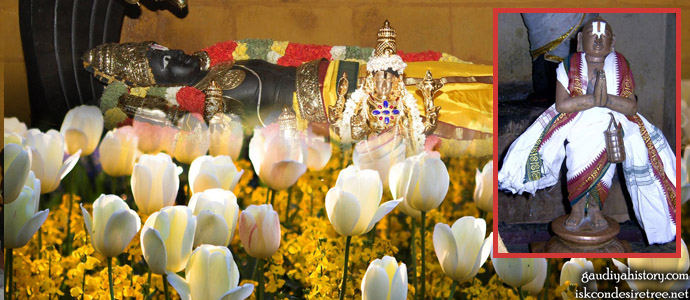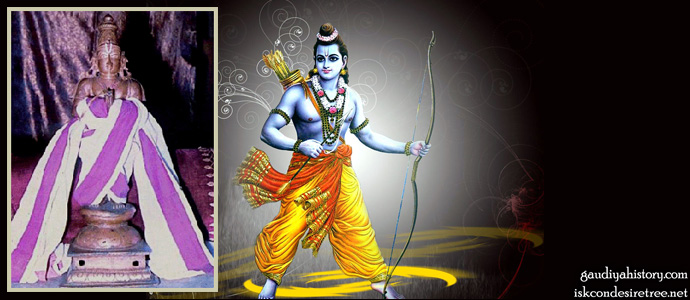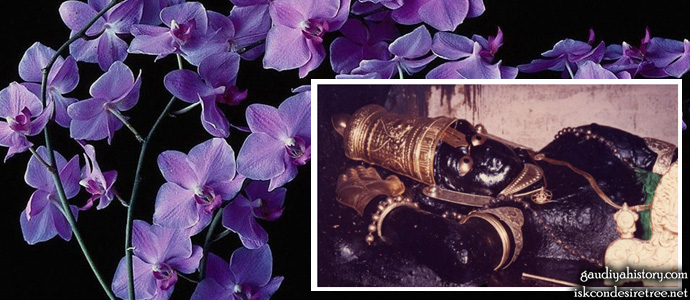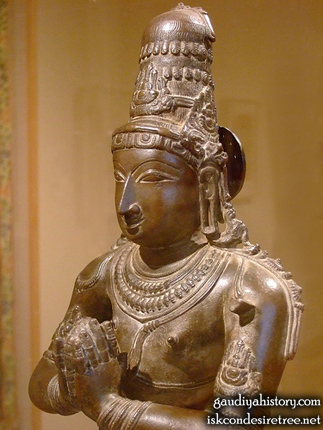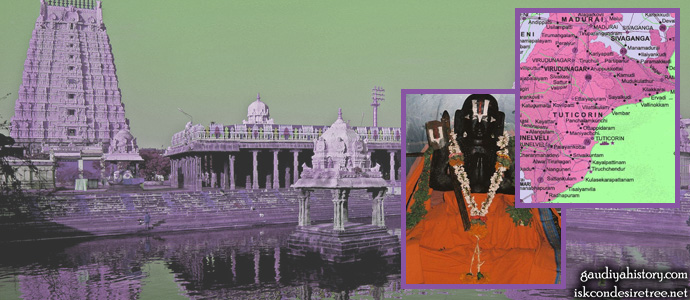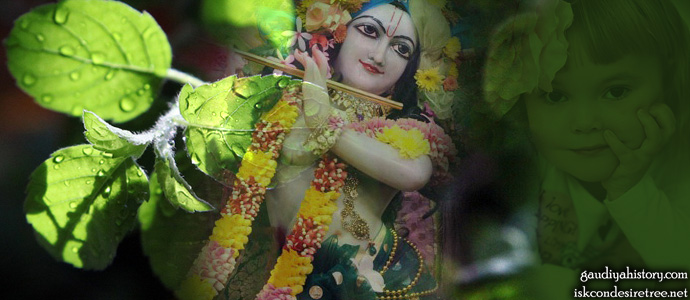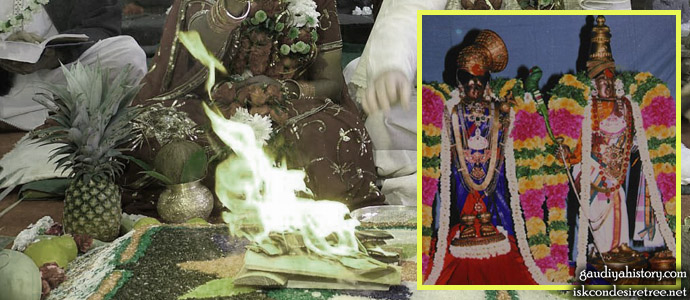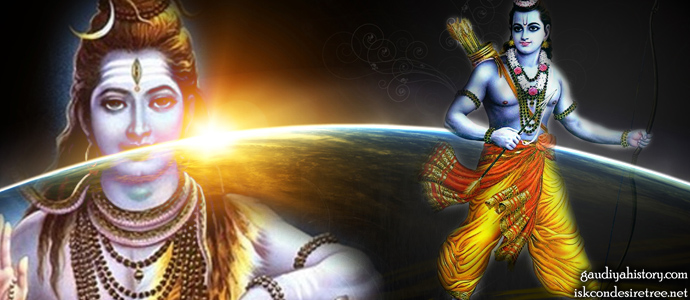Kalidvamsa, or Nila, was one of the Alvars. His story is particularly relevant to us, because his background was very, very fallen before he became a Devotee of the Lord. How he became a Devotee is also very interesting. Kalidvamsa means "destroyer of the influence of Kali." He was known by this name after he became a Devotee. But previously he was known as Nila which referred to his very dark complexion. He was fifth class, mleccha. He was of the Dravidan race, a South Indian race which can be extremely black-skinned.
But he was also of very strong body, very tall and very muscular. He had learned in his youth all the arts of fighting. Sword, spear, wrestling, boxing, he was extremely formidable. And he gathered around him a crew of particularly dangerous persons, who became like his gang. In those days, at the beginning of the Kali-yuga, mystical powers were a lot more prominent. One of his mates had the ability to hide in his own shadow.
Another one had the ability to pick any kind of lock or defensive mechanism, and he could do this very quickly. He had the ability to understand, just by looking, how the mechanism worked, and by a few deft movements of the hand it would come apart. And he could enter that place, steal whatever he wanted, and upon leaving he could reassemble the lock so that no-one would know that someone had been there. The third friend had the ability to silently kill anyone. By secret means, very silently, he could take a person's life. So these were Nila's friends.
They formed a very fearsome crew, and people were very afraid of them. The king of that region decided that the best policy with Nila was to employ him. So they engaged him as being the tax-collector for that district, and he was very effective. No-one dared hold back when Nila and his boys came to collect taxes for the government. Now, just outside that village where Nila was staying, there was one bathing tank, one pond and this was a place that was very beautiful, very special. So special that from time to time damsels from heaven would come down and also bathe there. So one day one young girl, who had come down with some other ladies from the heavenly planets, she was left there. One doctor from the village who was walking by saw this very beautiful young girl.

So they kept her at home, and since she was a young lady, she did not go out of the house. If she wanted to go outside, she would just go up to the roof. That was the system in those days, because unmarried girls should not mix with society. (In the wallpaper: a girl, a house).
He could immediately understand, due to her exquisitely beautiful features, that she wasn't from the region, and he asked, "Who are you?" And she answered," I don't know." Apparently she had suffered some kind of amnesia, and couldn't return to the heavenly planets. So the doctor asked the little girl to come with him, and he took her home, and introduced her to his wife, who was automatically very much taken by the little girl. She said, "Let us raise her as our daughter." So they kept her at home, and since she was a young lady, she did not go out of the house. If she wanted to go outside, she would just go up to the roof. That was the system in those days, because unmarried girls should not mix with society. So one day she was up on the roof, and Nila happened to come down the street, in front of the house, on his way somewhere. One point about Nila was that he was very much engaged in sense gratification, a very rowdy fellow, a boozer and a woman hunter.
He was carousing around on the street below, and when he happened to look up he saw this very beautiful girl. Immediately he was smitten with love for her, and he knocked on the door of the doctor's house. The doctor appeared at the door of the house and saw Nila standing there. "Oh," he said, "what can I do for you?" Nila replied, "I have just seen your beautiful daughter, and I want to ask her to be my wife." The doctor said, "Well it's not really in my power to give her to you as wife." Normally it's the father turning over the daughter to the would-be husband, but the doctor said, "It's not really up to me, because actually she's not my daughter. It appears to me that she's come from heaven. But you could ask her yourself if she would like to become your wife." So he brought the girl down. Her name was Kemuda, which means, "lotus." Nila proposed to her, "Let me take you as wife." He began to describe some of his qualifications to the girl. "You see this fist? This fist can punch and kill 500 people at once." Like this he was praising himself, and she was giggling shyly to herself, and she said, "I'm not interested in such things.
If you want to marry me, you have to become a Vaishnava." Because Nila was so much taken by the girl, he said, "Yes yes, no problem. I will become a Vaishnava." He had no idea of what a Vaishnava was, he had no idea what the word meant, but he just knew vaguely that a Vaishnava had something to do with the Temple. He had never gone to the big Temple that was in that area, he had never had any interest in it, but he'd heard this word Vaishnava used in connection with the Temple. Declaring he would immediately become a Vaishnava, he ran off in the direction of the Temple. He came in, and told the priest, the head Brahmin, "I want to become a Vaishnava." The Brahmin said, "Ok, so you know that a Vaishnava is completely surrendered to Lord Vishnu." "Yes yes yes," Nila said. "You know that a Vaishnava is only engaged in service to Vishnu and other Vaishnavas?" "Yeah yeah, no problem," Nila replied. "Well all right," said the Brahmin. "You're sure you want to be a Vaishnava?" "Of course," Nila said. So then the priest took the garland from the Deity and placed it around Nila's neck, and Nila came back very proudly to the doctor's house, and showed Kemuda that he wearing the garland from the Deity. "Now I am a Vaishnava," he said. But she said, "It is not enough just to officially be a Vaishnava. You have to act like one. If you want to marry me, then for one year you have to feed 1000 Vaishnavas every day, wash their feet, and drink the water."
"All right," he said. So then he went and got his mates. "Got a job for you," he said. "Oh great! What is it?" they said, rubbing their hands in anticipation. And then he explained, "Each day for the next year I want you to go out and fetch 1000 Vaishnavas, bring them here, and then we'll feed them. Then you should wash their feet and bring the water to me so I can drink it." His mates looked at him and said, "Are you feeling all right." Nila said, "Well look, if you don't get into this right now then you're not going to be feeling all right." So then, just as they were accustomed to do any other job, they did this job in the same fashion. They went running out onto the street armed with many weapons, and whenever they saw a Vaishnava they would immediately grab him by the scruff of his neck, and herd him into Nila's place, shouting, "Come on, let's go! Move it!" And these Vaishnavas would be saying, "What's happening?" "Now sit down there in a line," Nila's boys would say. And then they would come with the pots and slap the Prasadam down in front of them. "Eat!" The Vaishnavas would nervously take Prasadam. "Eat more!" They would make sure all the Vaishnavas were filled up. And then they would come with foot washing paraphernalia. "Stick out your foot!" And then they would bring a big barrel of Charanamrta to Nila, and he would scull it like a tankard. Pour it down his throat, wipe his mouth with the back of his hand and throw the barrel. So gradually by performing this service he began to transform.
Actually, saintly qualities began to manifest in his person. And furthermore, he became very attached to this service to the Vaishnavas. In the end he did marry Kemuda, but that was no longer his motivation for doing the service, he just liked to do it. He found it very sweet and enlivening. He became so enthusiastic for making arrangements for feeding 1000 Vaishnavas every day. You can just imagine his service was naturally increasing. The feast was becoming more and more opulent, the foot bathing ceremony became more and more opulent. In this way he was liberally spending money, until eventually he was out of cash, and he still hadn't completed his years service. In any case, he had no intention to stop after a year now. He just wanted to go on and on. So what to do, he had no more money with which to arrange for the feasts. But he had recently gathered together tax revenue to give to the king, and that was still at his place, a huge sum of money.
So he just started to spend that and continued on with his service. Now, meanwhile the king was expecting the tax money to be brought to his treasury house and it wasn't coming. So he was asking his ministers, "What's going on? Why hasn't Nila brought the money?" And then one minister said, "Well we have heard that this Nila is daily putting on huge feasts for the Vaishnavas, and it's becoming quite an opulent affair. Maybe that's where the money's going." The king was flabbergasted. "What?" And he immediately called for his commander-in-chief (senapati) the great general of his army, and with some soldiers, the commander-in-chief went to Nila's village to investigate and if necessary arrest Nila, and recover whatever tax money had not yet been wasted. So the commander-in-chief came and challenged Nila, announcing the purpose of his arrival. "I have come to investigate your doings," and he started to become very official with him. So one thing led to another, and there was a big fight, in which Nila soundly trounced the commander-in-chief and his soldiers. Because he was now, so to speak, a saintly person, he did not kill them but he gave them a severe beating. And he told the commander-in-chief as he was running off, "You can tell your king to come here personally if he likes, and I'll pay him the same tax as I paid you.!"
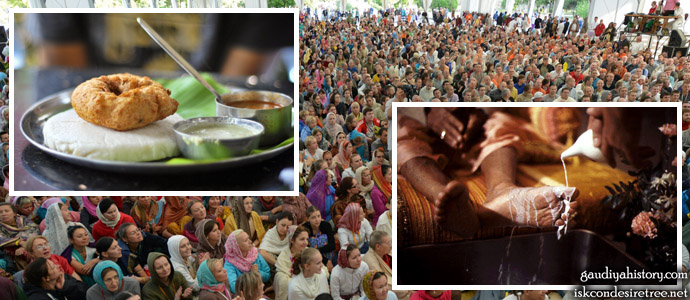
Actually, saintly qualities began to manifest in his person. And furthermore, he became very attached to this service to the Vaishnavas. In the end he did marry Kemuda, but that was no longer his motivation for doing the service, he just liked to do it. He found it very sweet and enlivening. He became so enthusiastic for making arrangements for feeding 1000 Vaishnavas every day. You can just imagine his service was naturally increasing. The feast was becoming more and more opulent, the foot bathing ceremony became more and more opulent. (In the wallpaper: Devotees in Ukraine Sadhu Sangam, Prasadam, Lotus Feet of Shrila Prabhupada).
So the commander-in-chief reported this to the king, and the king very angrily amassed his whole army and marched on that village. Nila met them in battle, and defeated the whole army. At the end of the battle Nila was standing on the king's chest, and the king was laying out on the battlefield. Nila was on his chest looking down at him saying, "That tax money I took, that was a loan, right?" And the king said, "Right!" But the king's ministers were there, his Brahmins, and they began to address Nila. "Certainly you are very powerful. You can defeat the king and his whole army. But that doesn't make what you are doing right. You have taken funds that were meant for the king's use, and the king's property is sacred. It is not to be violated by anyone for any purpose.
So because you have done this you have broken the law and you must be punished." So when the Brahmins were speaking to him in that way, because he had become purified he surrendered to them. "OK, if I have done wrong then I must be punished. What sort of punishment should I receive?" The Brahmins said, "You should go in the jail." Nila submitted. Although by force of arms he could not be captured, simply by logical argument and shastric evidence he surrendered. So he entered the prison of the king, but there of course he could no longer perform his service, so he became very, very unhappy and he prayed to Lord Vishnu, "I just want to serve You. I don't see how I can do it here in jail." So Vishnu appeared to him and told him, "You meet with the king and get him to transport you to Kanchipuram, and at the direction of Varadaraja you will find treasure, and this treasure will be so much that you will be able to pay the king what you owe him, and use the rest for your service."
So then Nila spoke to the king, he got the king's audience and explained the situation. The king sent him under guard to Kanchipuram, and somehow the Deity guided him to a particular spot and when he dug he found a great mass of treasure. So he brought that back to the king and offered to give what he owed him, but the king was so amazed that Lord Vishnu Himself had shown Nila where the treasure was, that he said, "Who am I to stand in your way? If Lord Vishnu is talking to you directly, then you must be a great soul." And then he let him go. So then Nila embarked on a new scheme. "There are so many rich vaishyas," he was saying to his mates, "They've got so much money. I see them transporting their goods here and there in caravans. And actually it's their duty to give donations to the service of the Vaishnavas, but they are not doing this. And here we are, we're having to worry about how to fund our project of serving the Devotees, and these vaishyas are just going here and there, using their wealth as the they like, so let us get it from them.
We will stop these caravans on lonely stretches of highway in the forest. We'll be nice, we'll ask them first of all if they would like to give a donation, but if they don't then we'll simply take everything." So they began this new scheme, and of course attached vaishyas never give donations willingly, so they always ended up having to tie them up and plunder the caravan, strip everything, and that they were utilizing as their wealth for serving the Vaishnavas. So one night they were going to plunder, and down the road came a very big caravan of 30 bullock carts, and at the head of the caravan was a very wonderful looking young merchant, and also his wife who was very beautiful, and they were dressed in all kinds of opulent finery, jewelry and crowns. The bullock carts were also being driven by servants who were equally opulent and wonderful in their appearance. So Nila stepped out on the road and stopped the whole procession, and he saw the opulence for the merchant and his wife and their caravan, and he remarked, "Well my dear sir, you look to be very, very wealthy." And the merchant smiled and said, "Yes, actually all wealth is mine." So Nila kind of laughed and turned to his mates, "Ha ha ha. We've really got a live tonight! Well if all wealth is yours then you won't mind parting with some of it." And the merchant smiled and said, "Yes, but my wealth is only engaged in Vaishnava-seva." So then they said, "Well that's very nice because I am a Vaishnava. So I'm sure you'll be happy to give me your wealth."
The merchant smiled again and said` "Well, I won't give you." "So you want to fight?" Nila asked. "No, you just take, said the merchant. "You are free to take, but I am not going to give." "All right," said Nila, "Let's go." So they tied them all up, as they normally did, and they stripped the bullock carts, and not only that but they also took all the finery from the merchant and his wife and their servants, all the jewels, everything. And the wife's foot, on her toe, there was one ring with a valuable gem in it. So Nila was trying to personally pull this ring off her toe, but it wouldn't come off. Finally he had to kneel down and bite the ring, to change it's shape a little bit so it would slip off. And while he was doing that, his consciousness was flooding with all sorts of wonderful ecstatic realizations.
But he was so much absorbed and determined to get this ring off that he really didn't take much note of it. And then he finally pulled the ring off, and all the wealth was piled together, and he and his men were going to carry it off, but they couldn't lift it. It was so heavy. So then he turned to the merchant and said, "I think you must have some mantra by which you move your wealth about, because obviously it is somehow charmed that it cannot be moved." And then the merchant said, "Yes, there is a secret mantra." "You'd better tell me," Nila demanded. "All right, just come close," the merchant said. So then He whispered in Nila's ear, "Om namo narayanayah." And when Nila heard this mantra he realized that this merchant and His wife were none other that Lakshmi and Narayana, and he saw them in Their original forms. So then he fell down at Their lotus feet, but because he was so furiously engaged in His devotional service, Nila quickly sprang up and said, "All right, look, we've gotta go. We'll see You tomorrow, OK" And then They said, "All right, you come here tomorrow. We can talk further."
So then Nila ran off with the wealth, and continued with his service. The next day he came back to that place in the forest, and Lakshmi and Narayana were there, and he worshipped Them. They were very pleased with him for his service to the Vaishnavas, but he declared to Them, "I'm always having trouble getting money to do this service, therefore I'm always having to plunder merchants, and I don't know where all this is going to lead. So do You have any suggestion where I can get wealth from?"
And Lord Narayana said, "Well actually, there are so many Buddha Temples around, and Buddha is My avatar, but He only came to preach to the atheists. However, these Buddha Temples have become quite opulent. So I don't mind if you plunder these Buddhist Temples." Nila was very happy. "Well actually I was thinking the same thing myself. But if I get Your permission, then that's wonderful."
"Yes, you have my permission," the Lord said. So then, when his wealth again ran out, then Nila and his monks went one night to a huge Buddhist monastery where 1000 monks were living. And in that Temple there was a huge reclining Buddha made out of solid gold. His men were using their various mystic powers to get them into the Temple. Nila was standing guard just outside the Temple door, and his men were in there at work, trying to dislodge the Deity and bring it out. So, while doing this they set off an alarm, and then the Buddhists came tumbling out of their beds and rushing into the Temple courtyard. They were all armed, and all very expert at martial arts.
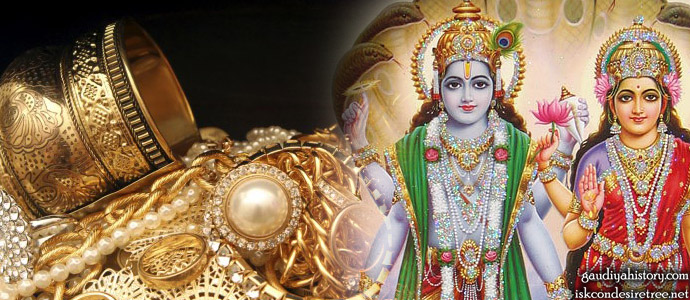
So then He whispered in Nila's ear, "Om namo narayanayah." And when Nila heard this mantra he realized that this merchant and His wife were none other that Lakshmi and Narayana, and he saw them in Their original forms. So then he fell down at Their lotus feet, but because he was so furiously engaged in His devotional service, Nila quickly sprang up and said, "All right, look, we've gotta go. We'll see You tomorrow, OK" And then They said, "All right, you come here tomorrow. We can talk further." (In the wallpaper: Shri Shri Lakshmi Narayana, golden jewelry).
So what ensued next was like something from a kung-fu movie. All these Buddhist monks were jumping at Nila, and he was kicking them back and fighting them off. And he was calling into the Temple, "Hey hurry up! Are you done in there?" But meanwhile his men were having difficulty, because they found that the murti was charmed, so as soon as they touched it to remove it, it started to spin, faster and faster like a helicopter propeller, from the middle point, and a huge heavy golden idol spinning like that, they couldn't get close to it. So then they were calling out to Nila, "We can't take this because it's spinning. It's charmed." So then Nila, while he was fighting off these men, he called out, "Well, just pass urine!" So they passed urine in there, and this broke the spell.
The murti stopped, and they could shoulder it. They were obviously very strong persons, and they ran out with it. Nila was fighting with the Buddhists, and then they went running through the night with the Buddhists pursuing them. Nila and his men went to Shri Rangam, a great Vishnu Temple. There is a great wall around it like a fortress, and they closed the door so the Buddhists couldn't enter. The Buddhists then went to the king and complained. The king was again in a difficult situation having to deal with Nila, so he called Nila in and said, "Nila, we have a little problem here. These Buddhists have accused you of stealing their murti. I'm the king here, I have to keep everyone happy. So I'd really appreciate it if you could return this murti." Some of the Buddhist leaders were also standing there, looking at Nila rather intensely. So Nila said, "Don't worry, don't worry. In two weeks I'll return this murti to you, not less than a finger."
Everyone was happy. "All right, we can wait two weeks." So then two weeks came, and the Buddhists gathered at the meeting place where Nila was to return the murti, but when they arrived they saw only Nila and his men there, and no murti. They became a little nervous. "Well, where's our Buddha?" Nila reached into his pocket and pulled out a finger, a golden finger. "Here it is," he said, "not less than a finger." The Buddhists became very angry, and there was a big fight. Nila defeated them and forced them to become Vaishnavas, forcibly converted them. And what he had done with that golden murti is that he had melted it down and used it to cover the dome above Lord Ranganatha. Nowadays you can go to Shri Rangakshetra, and if you talk to the right people you can go up to a look-out place on top of the Temple and see this very ornate solid gold dome, very huge. This was melted down from the Buddha murti by Nila.
In this way Nila became a very prominent Vaishnava of his time, and by force of arms if necessary he drove out the influence of Kali-yuga in his area. Everyone had to become a Vaishnava, he converted everyone. As he used to collect taxes, so wherever he would go everyone would become a Vaishnava immediately. And when there was a festival at Shri Rangakshetra, they would take the Deity in procession, and Nila would march in front of the Deity with his sword out, he would be looking from left to right at everyone. And when he was asked, "What are you doing? You look so fearsome with your sword out, looking so scrutinizing at everyone's face," and his answer would be, "Yes. Any offender I see will be chopped." So it was a rather intense mood in those festivals. He was the enforcer of Vaishnava-dharma. In spite of the influence of Kali-yuga which is so powerful to sweep away all proper religious principles, this Devotee Nila, in South India, by the force of his devotion as well as the force of his strong arms and use of weapons, he instituted Vaishnavism. By pleasing the Vaishnavas, he got the darshana of Lakshmi-Narayana. Actually this pastime when he was plundering their caravan, and in particular taking the ring from the lotus toe of Lakshmi, this is actually where the Lakshmi sampradaya started. Ramanuja later established the Lakshmi sampradaya with siddhanta, Vedantic conclusions, but the devotional line actually starts here with Nila taking the ring from Lakshmi's toe.
Source : http://vishoka.com/visoka/nectar/Alvars.htm
